 Technology peripherals
Technology peripherals
 AI
AI
 It's really so smooth: NeuralHDHair, a new 3D hair modeling method, jointly produced by Zhejiang University, ETH Zurich, and CityU
It's really so smooth: NeuralHDHair, a new 3D hair modeling method, jointly produced by Zhejiang University, ETH Zurich, and CityU
It's really so smooth: NeuralHDHair, a new 3D hair modeling method, jointly produced by Zhejiang University, ETH Zurich, and CityU
In recent years, the virtual digital human industry has exploded, and all walks of life are launching their own digital human images. There is no doubt that high-fidelity 3D hair models can significantly enhance the realism of virtual digital humans. Unlike other parts of the human body, describing and extracting hair structure is more challenging due to the extremely complex nature of the intertwined hair structure, making it extremely difficult to reconstruct a high-fidelity 3D hair model from just a single view. Generally speaking, existing methods solve this problem in two steps: first estimating a 3D orientation field based on the 2D orientation map extracted from the input image, and then synthesizing hair strands based on the 3D orientation field. However, this mechanism still has some problems in practice.
Based on observations in practice, researchers are seeking a fully automated and efficient hair model modeling method that can reconstruct a 3D hair model from a single image with fine-grained features (Figure 1), while Showing a high degree of flexibility, e.g. reconstructing a hair model requires only one forward pass of the network.
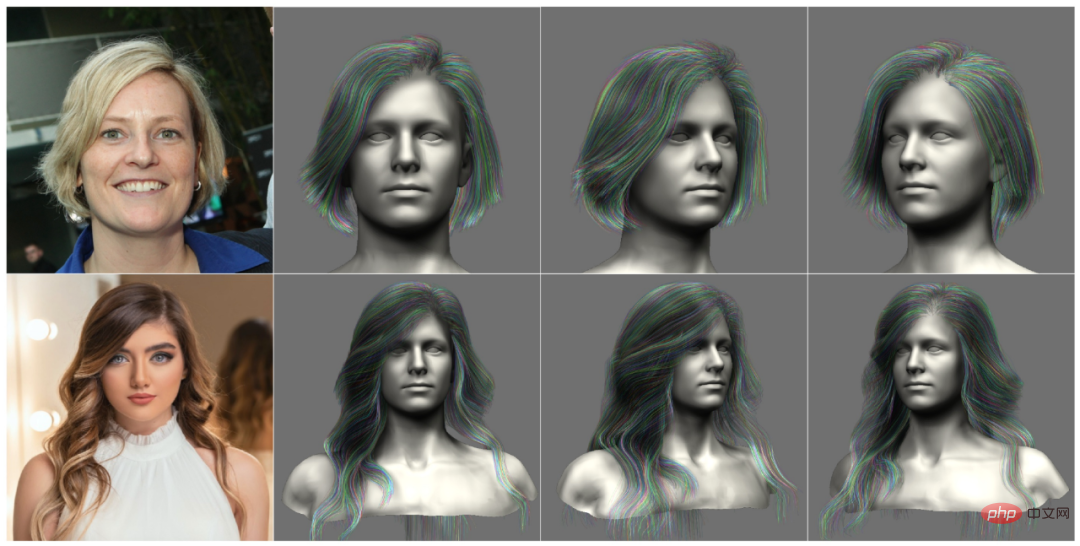
In order to solve these problems, researchers from Zhejiang University, ETH Zurich, Switzerland, and City University of Hong Kong proposed IRHairNet, which implements a rough Develop sophisticated strategies to generate high-fidelity 3D orientation fields. Specifically, they introduced a novel voxel-aligned implicit function (VIFu) to extract information from the 2D orientation map of the rough module. At the same time, in order to make up for the local details lost in the 2D direction map, the researchers used the high-resolution brightness map to extract local features and combined them with the global features in the fine module for high-fidelity hair styling.
In order to effectively synthesize hair models from 3D directional fields, researchers introduced GrowingNet, a hair growth method based on deep learning using local implicit grid representation. This is based on a key observation: although the geometry and growth direction of hairs differ globally, they have similar characteristics at specific local scales. Therefore, a high-level latent code can be extracted for each local 3D orientation patch, and then a neural latent function (a decoder) is trained to grow hair strands in it based on this latent code. After each growth step, a new local patch centered on the end of the hair strand is used to continue growing. After training, it can be applied to 3D oriented fields at any resolution.

Paper: https://arxiv.org/pdf/2205.04175.pdf
IRHairNet and GrowingNet form the core of NeuralHDHair. Specifically, the main contributions of this research include:
- Introduction of a novel fully automatic monocular hair modeling framework whose performance is significantly better than existing SOTA methods;
- Introduces a coarse-to-fine hair modeling neural network (IRHairNet), using a novel voxel-aligned implicit function and a brightness mapping to enrich local details of high-quality hair modeling;
- A new hair growing network (GrowingNet) based on local implicit functions is proposed, which can efficiently generate hair models with any resolution. This network achieves a certain order of magnitude improvement in speed compared to previous methods.
Method
Figure 2 shows the pipeline of NeuralHDHair. For a portrait image, its 2D orientation map is first calculated and its brightness map is extracted. Additionally, they are automatically aligned to the same bust reference model to obtain bust depth maps. These three graphs are then fed back to IRHairNet.
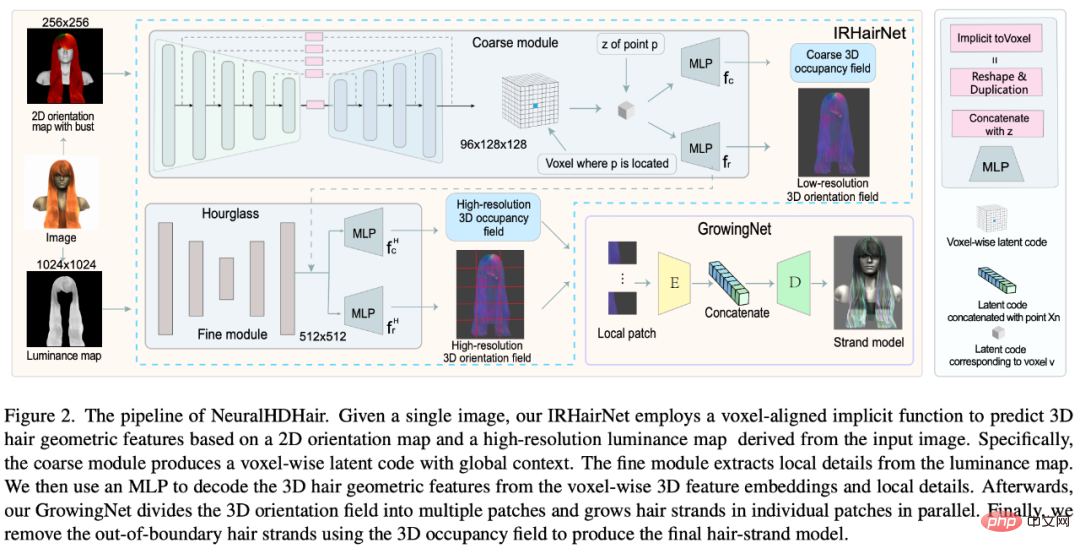
- IRHairNet is designed to generate high-resolution 3D hair geometric features from a single image. Inputs to this network include a 2D orientation map, a brightness map, and a fitted half-length depth map, which are obtained from the input portrait image. The output is a 3D orientation field, where each voxel contains a local growth direction, and a 3D occupancy field, where each voxel represents whether a hair strand has passed (1) or not (0).
- GrowingNet is designed to efficiently generate a complete hair model from the 3D orientation field and 3D occupancy field estimated by IRHairNet, where the 3D occupancy field is used to limit the hair growth area.
For more method details, please refer to the original paper.
Experiment
In this part, the researcher evaluates the effectiveness and necessity of each algorithm component through ablation studies (Section 4.1), and then combines the methods in this paper Compare with current SOTA (Section 4.2). Implementation details and more experimental results can be found in the supplementary material.
Ablation Experiment

The researchers evaluated the fidelity and efficiency of GrowingNet from a qualitative and quantitative perspective. First, three sets of experiments are conducted on synthetic data: 1) traditional hair growth algorithm, 2) GrowingNet without overlapping potential patch schemes, 3) the complete model of this paper.
As shown in Figure 4 and Table 1, compared with the traditional hair growth algorithm, GrowingNet in this article has obvious advantages in time consumption while maintaining the same growth performance in terms of visual quality. In addition, by comparing the third and fourth columns of Figure 4, it can be seen that if there is no overlapping potential patch scheme, the hair strands at the patch boundary may be discontinuous, which is a problem when the growth direction of the hair strands changes drastically. It's even more serious. However, it is worth noting that this solution greatly improves efficiency at the expense of slightly reducing accuracy. Improving efficiency is of great significance for its convenient and efficient application in human body digitization.
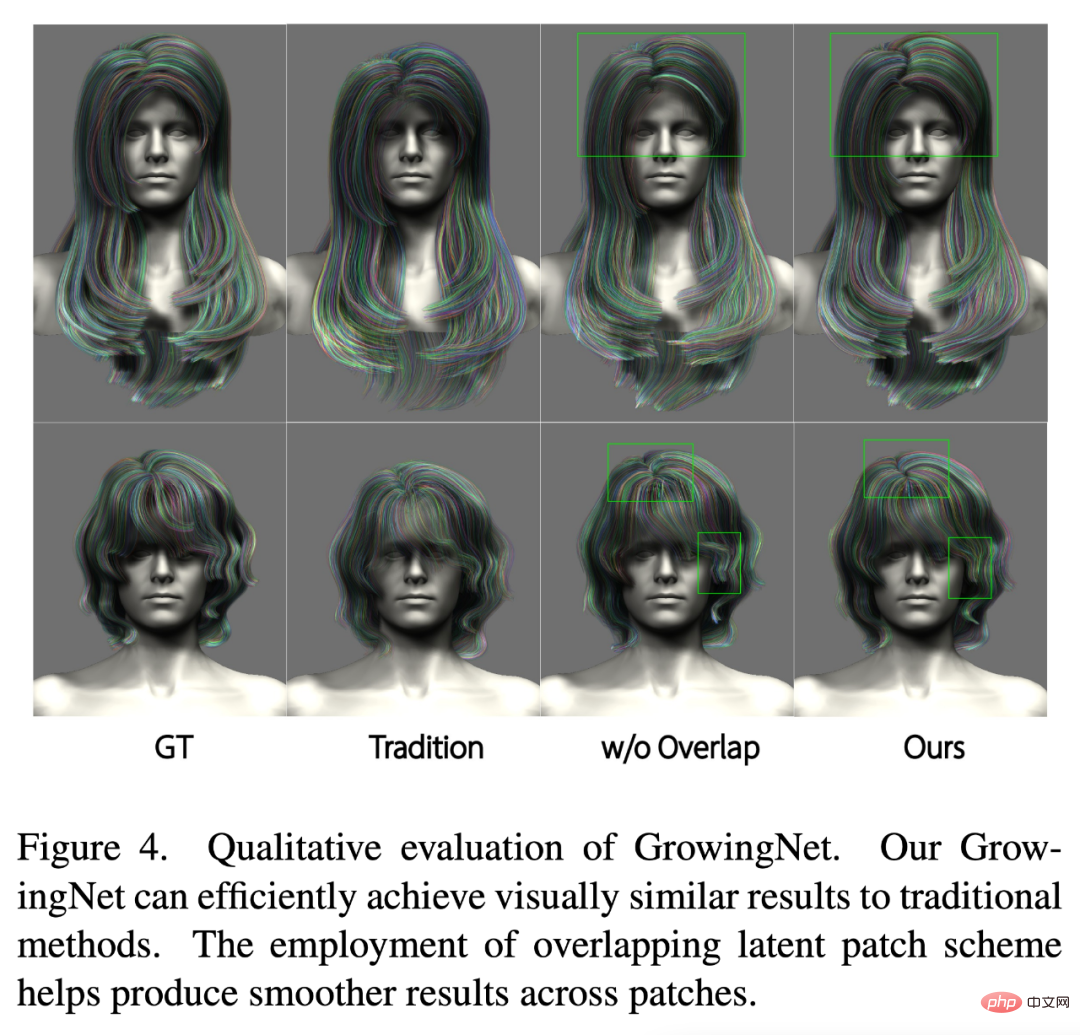

Comparison with SOTA method
In order to evaluate the performance of NeuralHDHair, the researchers compared Comparisons were made with some SOTA methods [6, 28, 30, 36, 40]. Among them, Autohair is based on a data-driven approach for hair synthesis, while HairNet [40] ignores the hair growth process to achieve end-to-end hair modeling. In contrast, [28,36] implement a two-step strategy by first estimating a 3D orientation field and then synthesizing hair strands from it. PIFuHD [30] is a monocular high-resolution 3D modeling method based on a coarse-to-fine strategy, which can be used for 3D hair modeling.
As shown in Figure 6, the results of HairNet look unsatisfactory, but the local details and even the overall shape are inconsistent with the hair in the input image. This is because the method synthesizes hair in a simple and crude way, recovering disordered hair strands directly from a single image.
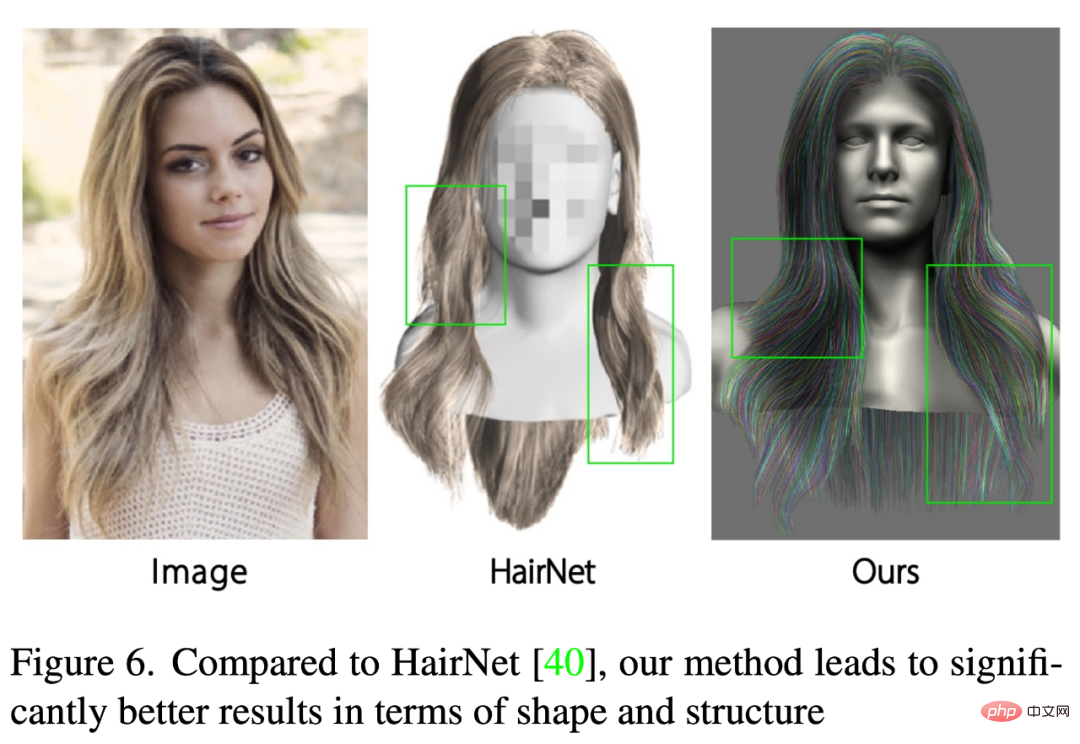
The reconstruction results are also compared with Autohair[6] and Saito[28]. As shown in Figure 7, although Autohair can synthesize realistic results, it does not structurally match the input image well because the database contains limited hairstyles. Saito's results, on the other hand, lack local details and have shapes inconsistent with the input image. In contrast, the results of this method better maintain the global structure and local details of the hair while ensuring the consistency of the hair shape.
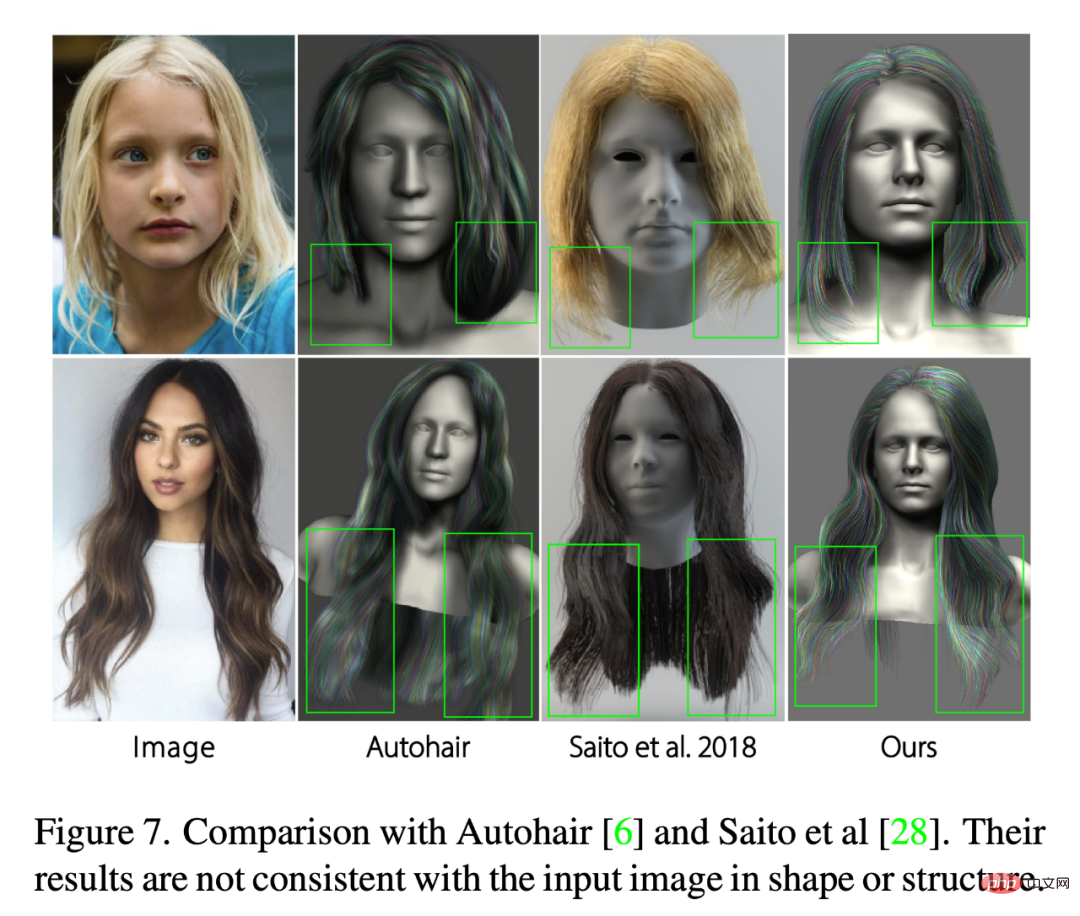
PIFuHD [30] and Dynamic Hair [36] are dedicated to estimating high-fidelity 3D hair geometric features to generate realistic hair strands Model. Figure 8 shows two representative comparison results. It can be seen that the pixel-level implicit function used in PIFuHD cannot fully depict complex hair, resulting in a result that is too smooth, has no local details, and does not even have a reasonable global structure. Dynamic Hair can produce more reasonable results with less detail, and the hair growth trend in its results can match the input image well, but many local structural details (such as hierarchy) cannot be captured, especially for complex hairstyles. In contrast, our method can adapt to different hairstyles, even extremely complex structures, and make full use of global features and local details to generate high-fidelity, high-resolution 3D hair models with more details.

The above is the detailed content of It's really so smooth: NeuralHDHair, a new 3D hair modeling method, jointly produced by Zhejiang University, ETH Zurich, and CityU. For more information, please follow other related articles on the PHP Chinese website!

Hot AI Tools

Undresser.AI Undress
AI-powered app for creating realistic nude photos

AI Clothes Remover
Online AI tool for removing clothes from photos.

Undress AI Tool
Undress images for free

Clothoff.io
AI clothes remover

AI Hentai Generator
Generate AI Hentai for free.

Hot Article

Hot Tools

Notepad++7.3.1
Easy-to-use and free code editor

SublimeText3 Chinese version
Chinese version, very easy to use

Zend Studio 13.0.1
Powerful PHP integrated development environment

Dreamweaver CS6
Visual web development tools

SublimeText3 Mac version
God-level code editing software (SublimeText3)

Hot Topics
 1377
1377
 52
52
 The world's most powerful open source MoE model is here, with Chinese capabilities comparable to GPT-4, and the price is only nearly one percent of GPT-4-Turbo
May 07, 2024 pm 04:13 PM
The world's most powerful open source MoE model is here, with Chinese capabilities comparable to GPT-4, and the price is only nearly one percent of GPT-4-Turbo
May 07, 2024 pm 04:13 PM
Imagine an artificial intelligence model that not only has the ability to surpass traditional computing, but also achieves more efficient performance at a lower cost. This is not science fiction, DeepSeek-V2[1], the world’s most powerful open source MoE model is here. DeepSeek-V2 is a powerful mixture of experts (MoE) language model with the characteristics of economical training and efficient inference. It consists of 236B parameters, 21B of which are used to activate each marker. Compared with DeepSeek67B, DeepSeek-V2 has stronger performance, while saving 42.5% of training costs, reducing KV cache by 93.3%, and increasing the maximum generation throughput to 5.76 times. DeepSeek is a company exploring general artificial intelligence
 AI subverts mathematical research! Fields Medal winner and Chinese-American mathematician led 11 top-ranked papers | Liked by Terence Tao
Apr 09, 2024 am 11:52 AM
AI subverts mathematical research! Fields Medal winner and Chinese-American mathematician led 11 top-ranked papers | Liked by Terence Tao
Apr 09, 2024 am 11:52 AM
AI is indeed changing mathematics. Recently, Tao Zhexuan, who has been paying close attention to this issue, forwarded the latest issue of "Bulletin of the American Mathematical Society" (Bulletin of the American Mathematical Society). Focusing on the topic "Will machines change mathematics?", many mathematicians expressed their opinions. The whole process was full of sparks, hardcore and exciting. The author has a strong lineup, including Fields Medal winner Akshay Venkatesh, Chinese mathematician Zheng Lejun, NYU computer scientist Ernest Davis and many other well-known scholars in the industry. The world of AI has changed dramatically. You know, many of these articles were submitted a year ago.
 Hello, electric Atlas! Boston Dynamics robot comes back to life, 180-degree weird moves scare Musk
Apr 18, 2024 pm 07:58 PM
Hello, electric Atlas! Boston Dynamics robot comes back to life, 180-degree weird moves scare Musk
Apr 18, 2024 pm 07:58 PM
Boston Dynamics Atlas officially enters the era of electric robots! Yesterday, the hydraulic Atlas just "tearfully" withdrew from the stage of history. Today, Boston Dynamics announced that the electric Atlas is on the job. It seems that in the field of commercial humanoid robots, Boston Dynamics is determined to compete with Tesla. After the new video was released, it had already been viewed by more than one million people in just ten hours. The old people leave and new roles appear. This is a historical necessity. There is no doubt that this year is the explosive year of humanoid robots. Netizens commented: The advancement of robots has made this year's opening ceremony look like a human, and the degree of freedom is far greater than that of humans. But is this really not a horror movie? At the beginning of the video, Atlas is lying calmly on the ground, seemingly on his back. What follows is jaw-dropping
 KAN, which replaces MLP, has been extended to convolution by open source projects
Jun 01, 2024 pm 10:03 PM
KAN, which replaces MLP, has been extended to convolution by open source projects
Jun 01, 2024 pm 10:03 PM
Earlier this month, researchers from MIT and other institutions proposed a very promising alternative to MLP - KAN. KAN outperforms MLP in terms of accuracy and interpretability. And it can outperform MLP running with a larger number of parameters with a very small number of parameters. For example, the authors stated that they used KAN to reproduce DeepMind's results with a smaller network and a higher degree of automation. Specifically, DeepMind's MLP has about 300,000 parameters, while KAN only has about 200 parameters. KAN has a strong mathematical foundation like MLP. MLP is based on the universal approximation theorem, while KAN is based on the Kolmogorov-Arnold representation theorem. As shown in the figure below, KAN has
 Google is ecstatic: JAX performance surpasses Pytorch and TensorFlow! It may become the fastest choice for GPU inference training
Apr 01, 2024 pm 07:46 PM
Google is ecstatic: JAX performance surpasses Pytorch and TensorFlow! It may become the fastest choice for GPU inference training
Apr 01, 2024 pm 07:46 PM
The performance of JAX, promoted by Google, has surpassed that of Pytorch and TensorFlow in recent benchmark tests, ranking first in 7 indicators. And the test was not done on the TPU with the best JAX performance. Although among developers, Pytorch is still more popular than Tensorflow. But in the future, perhaps more large models will be trained and run based on the JAX platform. Models Recently, the Keras team benchmarked three backends (TensorFlow, JAX, PyTorch) with the native PyTorch implementation and Keras2 with TensorFlow. First, they select a set of mainstream
 Tesla robots work in factories, Musk: The degree of freedom of hands will reach 22 this year!
May 06, 2024 pm 04:13 PM
Tesla robots work in factories, Musk: The degree of freedom of hands will reach 22 this year!
May 06, 2024 pm 04:13 PM
The latest video of Tesla's robot Optimus is released, and it can already work in the factory. At normal speed, it sorts batteries (Tesla's 4680 batteries) like this: The official also released what it looks like at 20x speed - on a small "workstation", picking and picking and picking: This time it is released One of the highlights of the video is that Optimus completes this work in the factory, completely autonomously, without human intervention throughout the process. And from the perspective of Optimus, it can also pick up and place the crooked battery, focusing on automatic error correction: Regarding Optimus's hand, NVIDIA scientist Jim Fan gave a high evaluation: Optimus's hand is the world's five-fingered robot. One of the most dexterous. Its hands are not only tactile
 FisheyeDetNet: the first target detection algorithm based on fisheye camera
Apr 26, 2024 am 11:37 AM
FisheyeDetNet: the first target detection algorithm based on fisheye camera
Apr 26, 2024 am 11:37 AM
Target detection is a relatively mature problem in autonomous driving systems, among which pedestrian detection is one of the earliest algorithms to be deployed. Very comprehensive research has been carried out in most papers. However, distance perception using fisheye cameras for surround view is relatively less studied. Due to large radial distortion, standard bounding box representation is difficult to implement in fisheye cameras. To alleviate the above description, we explore extended bounding box, ellipse, and general polygon designs into polar/angular representations and define an instance segmentation mIOU metric to analyze these representations. The proposed model fisheyeDetNet with polygonal shape outperforms other models and simultaneously achieves 49.5% mAP on the Valeo fisheye camera dataset for autonomous driving
 Single card running Llama 70B is faster than dual card, Microsoft forced FP6 into A100 | Open source
Apr 29, 2024 pm 04:55 PM
Single card running Llama 70B is faster than dual card, Microsoft forced FP6 into A100 | Open source
Apr 29, 2024 pm 04:55 PM
FP8 and lower floating point quantification precision are no longer the "patent" of H100! Lao Huang wanted everyone to use INT8/INT4, and the Microsoft DeepSpeed team started running FP6 on A100 without official support from NVIDIA. Test results show that the new method TC-FPx's FP6 quantization on A100 is close to or occasionally faster than INT4, and has higher accuracy than the latter. On top of this, there is also end-to-end large model support, which has been open sourced and integrated into deep learning inference frameworks such as DeepSpeed. This result also has an immediate effect on accelerating large models - under this framework, using a single card to run Llama, the throughput is 2.65 times higher than that of dual cards. one



